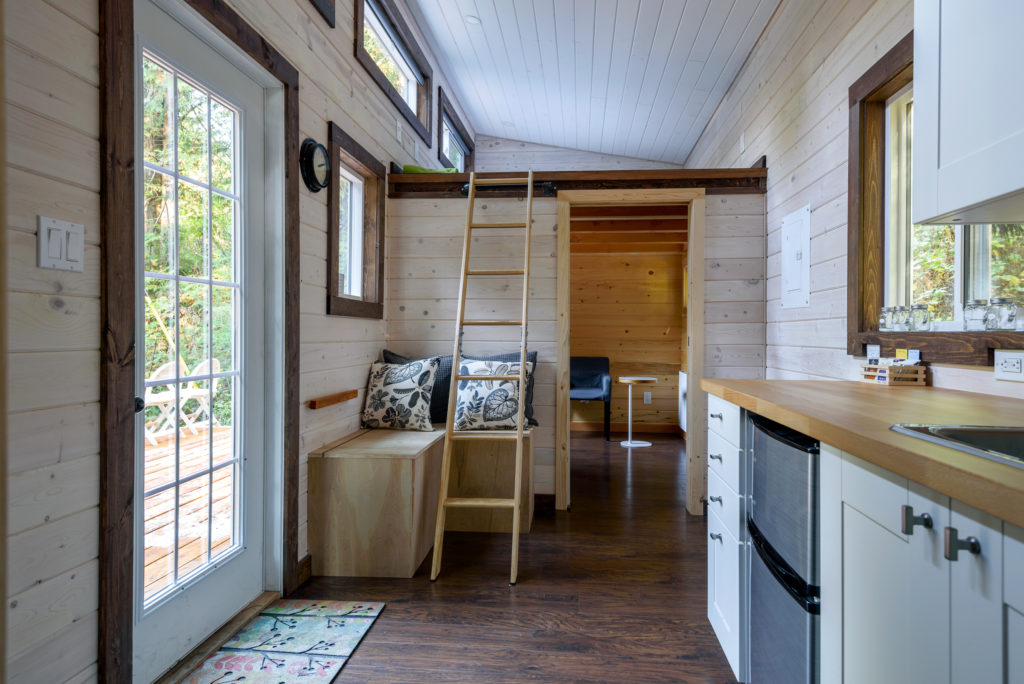7 small space design lessons we learned from the 'tiny home' trend
The tiny home movement continues to captivate homeowners and designers alike. People across the nation and around the world are trading 2,000 square feet houses for something much smaller - often under 500 square feet of floor space!
The philosophy behind this movement is compelling: trade a consumer-driven lifestyle for a more modest and environmentally friendly one. The benefits are substantial, including significant cost savings and a reduced ecological footprint.
However, like any dwelling, tiny homes present unique design challenges, particularly when selecting appropriate contract fabrics and furnishings that maximise limited space without creating clutter.
Here are 7 tips we've learned from this trend that can fit any living space.
1. Choose Multi-Functional Furniture with Performance Fabrics
Anything worthy of being in a tiny house needs to serve multiple purposes. One of the best ways to determine if that piece you're considering fits the bill is to ask: "Is it adaptable?"
Small space living demands versatile furniture options that free up floor space when not in use. A perfect example is the bed area. Ideal beds can be tucked away or transformed when not in use - think foldable beds that double as couches during the day, or beds that convert into dining tables.
Pro Tip: When selecting furniture for tiny spaces, invest in pieces upholstered with high-quality contract upholstery fabrics. These performance fabrics are specifically designed to withstand daily use while maintaining their appearance, making them ideal for furniture that serves multiple functions throughout the day.
Related read: The Tiny House Movement Gets a Luxury Upgrade >
2. Create Visual Space with Reflective Surfaces
Mirrors are essential in tiny houses because these brilliant reflectors effortlessly maximize the appearance of your open plan!
Strategic mirror placement helps direct light to darker, hard-to-reach areas in your tiny home. The key is finding the optimal positioning for the best reflection angles. For maximum effect, consider multiple mirrors with frames that complement your interior design.
Mirrors excel at creating the illusion of expanded space. Once you incorporate a few well-placed mirrors into your interior architecture, your small space will instantly appear much roomier than before.
Related read: 3 Glamorous Ways to Make Your Interiors Sparkle >
3. Embrace Clutter-Free Living with Stain-Resistant Fabrics
The tiny home movement celebrates simple, clutter-free living – which requires intentional choices. When evaluating potential furnishings, ask yourself these three questions:
- Does this item earn its place in my limited living space?
- Will this piece maximize usable square footage compared to alternatives?
- Does it complement the overall aesthetic and tiny home lifestyle?
If your answers are mostly affirmative, particularly to the last question, you've found a prime candidate! Functional pieces that enhance your tiny home's interior architecture become natural focal points.
Designer Secret: Opt for furniture upholstered in stain-resistant fabrics to maintain that clutter-free aesthetic. Modern performance fabrics are designed to repel liquids and resist staining, making them perfect for tiny homes where every surface needs to remain pristine and functional.
Related read: Entertaining in a Small Space: The Only Guide You Need >
4. Evaluate Items for Joy and Utility
Over time, unused items become obstacles to your daily flow. To prevent accumulating unnecessary possessions, test specific items for a week.
Monitor how frequently you use each piece compared to how often you merely look at it. If you're looking at it more than using it (and it's not purely decorative), consider removing it sooner rather than later.
Related read: How to Go Maximalist in Your Interior Design - Without the Clutter >
5. Smart Storage Solutions with Durable Fabrics
Some infrequently used essentials must still find a home in your tiny living space. To accommodate these items without cluttering your environment, strategic storage solutions are crucial.
Seek out furniture with built-in storage functionality, such as bed frames with drawers or seating with hidden compartments. These clever solutions allow you to maintain your clutter-free environment while keeping essentials within reach.
Design Tip: For built-in seating with storage, select contract fabrics that combine durability with style. Today's contract upholstery fabrics offer exceptional performance characteristics – including stain resistance, fade resistance, and easy cleaning – while also providing designer-worthy colours and textures.
6. Color Play with Performance Fabrics
While functional furniture and multipurpose items are essential, bland design isn't part of the tiny house movement. Your micro home should be beautiful, simple, and comfortable.
Experiment with colour options to find perfect shades that complement your furniture, mood, and preferred style. Performance fabrics now come in virtually unlimited colour options, allowing you to create bold, personalized spaces without sacrificing durability.
Related read: The Essential Colour Aesthetic Guide from FibreGuard's Design Team >
7. Invest in PFAs-Free Performance Fabrics
As tiny homes emphasise environmental consciousness, extend this philosophy to your fabric choices. Modern performance fabrics and contract upholstery fabrics are increasingly available in PFAs-free options, eliminating potentially harmful forever chemicals while maintaining superior stain resistance.
Our eco-friendly performance fabrics deliver the same benefits as traditional options – durability, easy maintenance, and resistance to stains – while aligning with the sustainable values central to the tiny home movement.
Keeping reading about why FibreGuard upholstery fabrics are safe and non-toxic >


Making the Most of Your Tiny Home
Creating an effective tiny home environment is achievable with the right design approach and materials. Ideal furnishings include foldable furniture and items that provide storage space while maintaining a clutter-free aesthetic. When selecting upholstery, prioritize contract-grade performance fabrics that offer stain resistance, durability, and easy maintenance.
Start your design process from the floor and work upward, remembering that strategic boldness can yield impressive results in small spaces. With thoughtful selection of furniture, fabrics, and decor, your tiny home can become a beautiful, functional sanctuary that reflects your personal style while supporting a simplified lifestyle.
Ready to transform your tiny space? Explore our collection of PFAs-free performance fabrics designed specifically for small-space living!